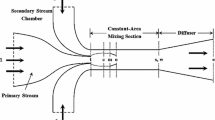Abstract
The supersonic ejector-diffuser system with a second throat was simulated using CFD. An explicit finite volume scheme was applied to solve two-dimensional Navier-Stokes equations with standard k – ε turbulence model. The vacuum performance of the supersonic ejector-diffuser system was investigated by changing the ejector throat area ratio and the operating pressure ratio. Two convergent-divergent nozzles with design Mach number of 2.11 and 3.41 were selected to give the supersonic operation of the ejector-diffuser system. The presence of a second throat strongly affected the shock wave structure inside the mixing tube as well as the spreading of the under-expanded jet discharging from the primary nozzle. There were optimum values of the operating pressure ratio and ejector throat area ratio for the vacuum performance of the system to maximize.
Similar content being viewed by others
References
Fabri, J.; Siestrunck, R. “Supersonic Air Ejectors,” Advance in Applied Mechanics, N. Y. Academic Press, 5, pp. 1–34, (1958).
Alperin, M.; Wu, J. J. “Thrust Augmenting Ejectors, Part 2,” AIAA Journal, 21, No.12, pp. 1698–1706, (1983).
Yang, T. T.; Ntone, F.; Jiang, T.; Pitts, D. R. An Investigation of High Performance, Short Thrust Augmenting Ejectors,” ASME Journal of Fluid Engineering, 107, pp. 23–30, (1985).
Matsuo, K.; Sasaguchi, K; Tasaki, K.; Mochizuki, H. “Investigation of Supersonic Air Ejectors, Part 1, Performance in the Case of Zero-Secondary Flow,” Bulletin of JSME, Ser. B, 24, No.198, pp. 2090–2097, (1981).
Liu, C. F.; Chen, F., “Analysis of Performance of the Second-Throat Ejector-Diffuser,” Journal of the Chinese Mechanical Engineering Society, 13, No. 5, pp. 478–482, (1992).
Keenan, J. H.; Neumann, E. P.; Lustwerk, F.: “An Investigation of Ejector Design by Analysis and Experiment,” Journal of Applied Mechanics, 17, No. 3, pp. 299–309, (1950).
Francis, W. E.; Hoggarth, M. L.; Templeman, J. J.: “The Design of Jet Pumps and Injectors for Gas Distribution and Combustion Purposes,” Proceedings of Symposium on Jet Pumps and Ejectors, BHRA Fluid Engineering-Institution of Chemical Engineers, No. 6, pp. 81–96, (1972).
Hsu, C. T.; “Investigation of an Ejector Heat Pump by Analytical Methods,” ORNL/CON-144, Oak Ridge National Laboratory, (1972).
Chow, W. L.; Addy, A. L.: “Interaction between Primary and Secondary Streams of Supersonic Ejector Systems and Their Performance Characteristics,” AIAA Journal, 11, No.4, (1964).
Quinn, B. “Ejector Performance at High Temperatures and Pressures,” Journal of Aircraft, 13, No. 12, pp. 948–954, (1976).
Tillman, T. G.; Presz, Jr. W. M.: “Thrust Characteristics of a Supersonic Mixer Ejector,” Journal of Propulsion and Power, 11, No. 5, pp. 931–937, (1995).
Nicholas, T. M. T.; Narayanan, A. K.; Muthunayagam, A. E.: “Mixing Pressure Rise Parameter for Effect of Nozzle Geometry in Diffuser-Ejectors,” Journal of Propulsion and Power, 12, No. 2, pp. 431–433, (1995).
Kurian, J.: “Mixing Performance of Radially Lobed Supersonic Nozzles,” Proceedings of 13th International Symposium on Air Breathing Engines, ISABE 97-7122, 1, pp. 891–900, (1997).
Srikrishnan, A. R.; Kurian, J.; Sriramulu, V.: “An Experimental Study on Mixing Enhancement by Petal Nozzle in Supersonic Flow,” Journal of Propulsion and Power, 12, No. 1, pp. 165–169, (1996).
Kumar, R. R.; Kurian, J.: “Estimation of Mixing of High-Speed Streams,” Journal of Propulsion and Power, 12, No. 2, pp. 429–431, (1995).
Chen, F.; Liu, C. F.; Yang, J. Y.: “Supersonic Flow in the Second-Throat Ejector-Diffuser System,” Journal of Spacecraft and Rockets, 31, No. 1, pp. 123–129, (1994).
Wang, J. J.; Chen, F.: “On the Start Condition of a Second-Throat Ejector-Diffuser,” Aeronutical Journal, 35, pp. 321–326, (1996).
Matsuo, K.; Sasaguchi, K.; Tasaki, K.; Mochizuki, H.: “Investigation of Supersonic Air Ejectors, Part 2, Effects of Throat-Area-Ratio on Ejector Performance,” Bulletin of JSME, Ser. B, 25, No. 210, pp. 1898–1905, (1982).
Matsuo, K.; Kim, H. D.: “Shock Train and Pseudo-Shock Phenomena in Internal Gas Flows,” Progress in Aerospace Sciences, 35, No. 1, pp. 33–100, (1999).
Author information
Authors and Affiliations
Rights and permissions
About this article
Cite this article
Kim, HD., Setoguchi, T., Yu, S. et al. Navier-Stokes computations of the supersonic ejector-diffuser system with a second throat. J. of Therm. Sci. 8, 79–83 (1999). https://doi.org/10.1007/s11630-999-0028-2
Issue Date:
DOI: https://doi.org/10.1007/s11630-999-0028-2



